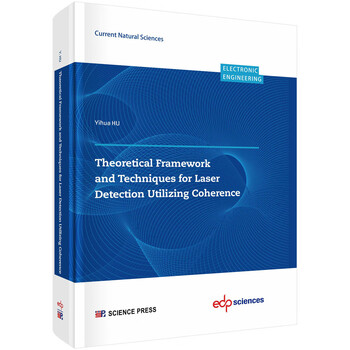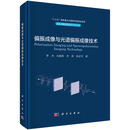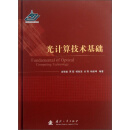内容简介
《Theoretical Framework and Techniques for Laser Detection Utilizing Coherence》为作者团队在相干激光探测领域多年研究的原创成果,共分为五章,系统介绍了激光相干探测技术在运动目标大气扰动探测、测距测速、微多普勒效应探测、合成孔径探测应用中涉及的相关理论和方法。**章为激光相干探测理论基础,主要介绍激光相干探测基础知识、激光相干探测特点、相干性影响分析、应用现状及典型系统。第二章为运动目标大气扰动的激光相干探测,从运动目标产生的大气CO2扰动和风场扰动激光相干探测两个方面,按照探测原理、探测系统、实验验证的思路进行介绍。第三章为激光相干测距测速,主要介绍啁啾调幅激光相干雷达测距和线性调频激光相干雷达测距测速。第四章为微多普勒效应的激光相干探测,介绍了微多普勒效应激光相干探测建模,以及基于时频分析的微动特征快速提取和基于信号模型的微动参数估计方法。测原理、信号设计、成像算法、相位补偿算法,以及合成孔径激光雷达实验系统及实验验证结果。
精彩书摘
Chapter 1
Theoretical Basis of Laser Coherent Detection
Laser is honored as the magic light. It has been more than one century since 1916 when Albert Einstein proposed the theory of stimulated emission of radiation, followed by the invention of the first laser beam in 1960. Laser has obvious advantages, including good directivity, small angle of divergence, extreme brightness, large energy density, pure color, good monochromaticity, and high coherence. Laser coherent detection is one of the main ways of laser detection. Compared with direct detection, laser coherent detection has advantages including high conversion gain, favorable filter performance, abundant detectable information characteristics, and high sensitivity. Therefore, it has been widely applied to the high-accuracy detection of targets. Starting with the basic concept of laser detection, the chapter introduces the fundamental principles, main technology indexes, characteristics,and typical applications of laser coherent detection.
1.1 Overview of Laser Detection
Like nuclear energy and semiconductors, the laser is another major discovery of humans. Laser is the acronym for “light amplification by stimulated emission of radiation,' which has fully expressed the main generation process of laser: light radiated by stimulated atoms.
A radar that uses a laser as the source of radiation for target detection is called a lidar, which is the typical laser detection system. Taking laser as the carrier, lidars carry information using the amplitude, wavelength, phase, or polarization and finally achieve the target detection function by combining with different transceiver systems.
The light and microwave both belong to electromagnetic waves, so lidars and microwave radars do not have essential differences in terms of the detection principle. The difference not only lies in that the laser wavelength is far shorter than microwave wavelength, but also in the generation, emission, modulation, and receiving modes. Compared with microwave radar detection, lidar detection mainly has the following advantages:
(1) Extremely high angular resolution. According to the Rayleigh criterion, the resolution is in direct proportion to the wavelength while in negative proportion to the receiving aperture. The wavelength of lidars is mainly in the near-infrared, visible, and ultraviolet bands, which are far smaller than microwaves, so an extremely high resolution can be obtained even if a small receiving aperture is used.
(2) Extremely high range resolution. Similar to pulse ranging, the laser pulse width can be as narrow as picoseconds, which corresponds to a range resolution at the millimeter level. In addition, laser beams are narrow and have a small footprint, which also helps to improve the range resolution.
(3) High Doppler velocity resolution. During the relative motion of a target in the line-of-sight of a radar, the magnitude of the Doppler shift generated by received echoes is negatively proportional to the wavelength. Because lidars have a wavelength far shorter than microwaves, their Doppler shift is in a larger range, which is conducive to realizing extremely high-velocity resolution.
According to the difference in detection targets, laser detection can be divided into two types. One is “soft” target detection, which detects the properties of atmospheric substances in the laser transmission path, such as atmospheric component, wind-field, and turbulence measurement, based on atmospheric backscattering; the other is “hard” target detection, which detects ontological attributes of targets, such as moving target reconnaissance, based on laser reflection by target surfaces.
According to the difference in detection modes,laser detection can also be divided into two types: direct detection and coherent det
目录
Contents
Preface Foreword
CHAPTER 1
Theoretical Basis of Laser Coherent Detection 1
1.1 Overview of Laser Detection 1
1.2 Principles of Laser Coherent Detection 2
1.2.1 Square-Law Characteristic of Photoelectric Detectors 3
1.2.2 Characterization of Laser Coherent Detection Signals 3
1.3 Signal-to-Noise Ratio of Laser Coherent Detection 5
1.3.1 Noise of Photoelectric Detectors 5
1.3.2 Signal-to-Noise Ratio of Coherent Detection 7
1.4 Coherence Efficiency of Laser Coherent Detection 9
1.4.1 Signal and LO Optical Fields 9
1.4.2 Coherence Efficiency Analysis 11
1.5 Basic Characteristics of Laser Coherent Detection 11
1.6 Overview of Typical Applications of Laser Coherent Detection 13
1.6.1 Laser Detection of Atmospheric Disturbances 13
1.6.2 Laser Ranging and Velocity Measurement 17
1.6.3 Laser Detection Based on the Micro-Doppler Effect 20
1.6.4 High-Resolution Synthetic Aperture Laser Imaging 23
References 27
CHAPTER 2
Laser Coherent Detection of Atmospheric Disturbances 29
2.1 Fundamental Principles 29
2.1.1 Radar Equation for Laser Detection of Atmosphere 29
2.1.2 Fundamental Principles of Laser Coherent Atmospheric BCO2 Detection 32
2.1.3 Fundamental Principles of Laser Coherent Detection of Wind-Field Disturbances 39
2.2 Experimental System for Laser Coherent Detection of Atmospheric Disturbances 42
2.2.1 Overall Structure of the Detection System 42
2.2.2 Parameter Design of the Detection System 46
2.2.3 Pulse Data Processing of Detection Echoes 57
2.3 Laser Coherent Detection Experiments of Atmospheric Disturbances 62
2.3.1 Atmospheric CO2 Detection Experiments 62
2.3.2 Atmospheric Wind-Field Detection Experiments 68
References 74
CHAPTER 3
Chirped AM Laser Coherent Detection of Range and Velocity 77
3.1 Fundamental Principles 77
3.1.1 Principle of Chirped AM Ranging 79
3.1.2 Principle of Chirped AM Velocity Measurement 79
3.2 Characteristics of Chirp Signals and De-Chirping 80
3.2.1 Chirp Signals and Their Ambiguity Function 80
3.2.2 Pulse Compression by a Matched Filter 83
3.2.3 Frequency-Domain Pulse Compression of Chirp Signals 84
3.2.4 Range-Velocity Coupling 86
3.3 Balanced Coherent Detection 87
3.4 Chirped AM Laser Coherent Detection Experiment of Range and Velocity 88
3.4.1 Chirped AM Laser Heterodyne Coherent Detection Experiments of Range 89
3.4.2 Chirped AM Laser Homodyne Coherent Detection Experiments of Range and Velocity 95
References 102
CHAPTER 4
Laser Coherent Detection Based on the Micro-Doppler Effect 103
4.1 Fundamental Principles of the Micro-Doppler Effect for Laser Detection 103
4.1.1 Doppler and Micro-Doppler Effects 103
4.1.2 Modeling of Echoed Photocurrent Signals in Target Vibration Detection 105
4.1.3 Modeling of Echoed Photocurrent Signals of Targets with Multiple Scattering Points 108
4.1.4 Influencing Factors of Characteristics of Laser Micro-Doppler Signals 112
4.2 Target Micro-Doppler Signal Acquisition and Experimental System for Laser Coherent Detection 119
4.3 Target Micro-Motion Feature Extraction Based on TFA 121
4.3.1 TFA of Micro-Doppler Signals of Targets 121
4.3.2 Decomposition of Time-Frequency Features
of Multi-Component Signals Based on Curve Tracking 125
4.3.3 Separation and Extraction of Time-Frequency Features
of Micro-Motions Based on Empirical Mode Decomposition 128
4.4 Micro-Motion Parameter Estimation Based on Signal Models 132
4.4.1 Micro-Motion Parameter Estimation Using PF Based on SPM 132
4.4.2 Micro-Motion Parameter Estimation Based on ML 136
References 152
CHAPTER 5
Laser Coherent Detection
试读
Chapter 1
Theoretical Basis of Laser Coherent Detection
Laser is honored as the magic light. It has been more than one century since 1916 when Albert Einstein proposed the theory of stimulated emission of radiation, followed by the invention of the first laser beam in 1960. Laser has obvious advantages, including good directivity, small angle of divergence, extreme brightness, large energy density, pure color, good monochromaticity, and high coherence. Laser coherent detection is one of the main ways of laser detection. Compared with direct detection, laser coherent detection has advantages including high conversion gain, favorable filter performance, abundant detectable information characteristics, and high sensitivity. Therefore, it has been widely applied to the high-accuracy detection of targets. Starting with the basic concept of laser detection, the chapter introduces the fundamental principles, main technology indexes, characteristics,and typical applications of laser coherent detection.
1.1 Overview of Laser Detection
Like nuclear energy and semiconductors, the laser is another major discovery of humans. Laser is the acronym for “light amplification by stimulated emission of radiation,' which has fully expressed the main generation process of laser: light radiated by stimulated atoms.
A radar that uses a laser as the source of radiation for target detection is called a lidar, which is the typical laser detection system. Taking laser as the carrier, lidars carry information using the amplitude, wavelength, phase, or polarization and finally achieve the target detection function by combining with different transceiver systems.
The light and microwave both belong to electromagnetic waves, so lidars and microwave radars do not have essential differences in terms of the detection principle. The difference not only lies in that the laser wavelength is far shorter than microwave wavelength, but also in the generation, emission, modulation, and receiving modes. Compared with microwave radar detection, lidar detection mainly has the following advantages:
(1) Extremely high angular resolution. According to the Rayleigh criterion, the resolution is in direct proportion to the wavelength while in negative proportion to the receiving aperture. The wavelength of lidars is mainly in the near-infrared, visible, and ultraviolet bands, which are far smaller than microwaves, so an extremely high resolution can be obtained even if a small receiving aperture is used.
(2) Extremely high range resolution. Similar to pulse ranging, the laser pulse width can be as narrow as picoseconds, which corresponds to a range resolution at the millimeter level. In addition, laser beams are narrow and have a small footprint, which also helps to improve the range resolution.
(3) High Doppler velocity resolution. During the relative motion of a target in the line-of-sight of a radar, the magnitude of the Doppler shift generated by received echoes is negatively proportional to the wavelength. Because lidars have a wavelength far shorter than microwaves, their Doppler shift is in a larger range, which is conducive to realizing extremely high-velocity resolution.
According to the difference in detection targets, laser detection can be divided into two types. One is “soft” target detection, which detects the properties of atmospheric substances in the laser transmission path, such as atmospheric component, wind-field, and turbulence measurement, based on atmospheric backscattering; the other is “hard” target detection, which detects ontological attributes of targets, such as moving target reconnaissance, based on laser reflection by target surfaces.
According to the difference in detection modes,laser detection can also be divided into two types: direct detection and coherent det























